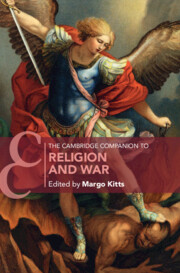Book contents
- The Cambridge Companion to Religion and War
- Cambridge Companions to Religion
- The Cambridge Companion to Religion and War
- Copyright page
- Contents
- Contributors
- Preface
- Introduction
- Part I Classical Foundations
- 1 Biblical Paradigms of War in History and Eschatology
- 2 Early Christianity and War
- 3 Fighting and Martial Valor in Islamic Thought
- 4 Hinduism and War
- 5 Buddha in the Ring of Fire
- 6 Sikhism
- 7 Religion and War in Traditional China
- 8 Buddhism and War in Premodern Japan
- Part II Just War
- Part III Religious Nationalism
- Part IV Featured Conflicts
- Index
- Cambridge Companions to Religion (continued from page ii)
- References
5 - Buddha in the Ring of Fire
The Buddhist Ethics of Warfare
from Part I - Classical Foundations
Published online by Cambridge University Press: 04 May 2023
- The Cambridge Companion to Religion and War
- Cambridge Companions to Religion
- The Cambridge Companion to Religion and War
- Copyright page
- Contents
- Contributors
- Preface
- Introduction
- Part I Classical Foundations
- 1 Biblical Paradigms of War in History and Eschatology
- 2 Early Christianity and War
- 3 Fighting and Martial Valor in Islamic Thought
- 4 Hinduism and War
- 5 Buddha in the Ring of Fire
- 6 Sikhism
- 7 Religion and War in Traditional China
- 8 Buddhism and War in Premodern Japan
- Part II Just War
- Part III Religious Nationalism
- Part IV Featured Conflicts
- Index
- Cambridge Companions to Religion (continued from page ii)
- References
Summary
This chapter dispels the guiding misconception of Buddhist pacifism, historically and textually, with reference to its origins in the early transmission of Buddhism to the West and the influence of mistranslations of ahiṃsā in the distorting modern discourse of “nonviolence” versus violence. At the same time, it highlights the Buddhist ideal of nonharm and the nuanced ways in which Buddhists applied compassionate values to the avoidance of armed conflict, the effective and ethical conduct of warfare, and postwar reconciliation.
Keywords
- Type
- Chapter
- Information
- The Cambridge Companion to Religion and War , pp. 114 - 140Publisher: Cambridge University PressPrint publication year: 2023



